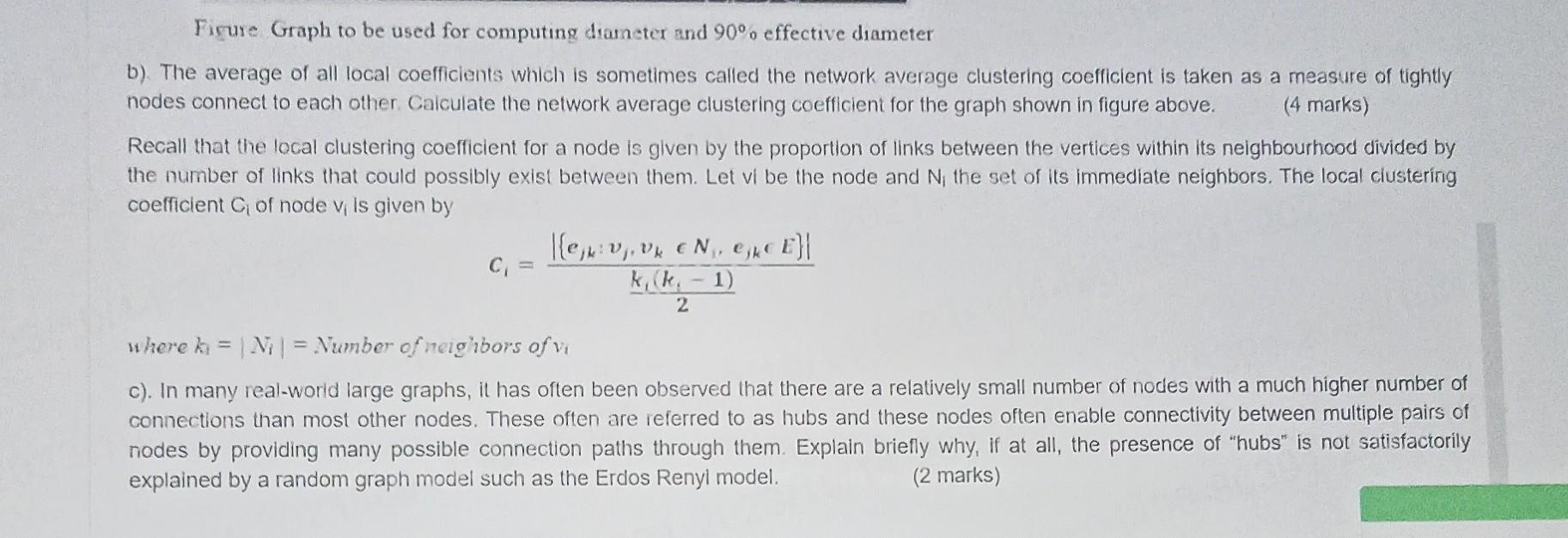Answered step by step
Verified Expert Solution
Question
1 Approved Answer
05 Guesion No: 02 a). Briefly explain the terms diameter and 90% effective diameter in the context of graphs. For the graph shown in


05 Guesion No: 02 a). Briefly explain the terms diameter and 90% effective diameter in the context of graphs. For the graph shown in figure below, what is the diameter and 90% effective diameter? (4 marks) 1 2 3 4 5 6 7 Figure Graph to be used for computing diameter and 90% effective diameter clustering .coefficient is taken as a meas Figure Graph to be used for computing diameter and 90% effective diameter b). The average of all local coefficients which is sometimes called the network average clustering coefficient is taken as a measure of tightly nodes connect to each other. Calculate the network average clustering coefficient for the graph shown in figure above. (4 marks) Recall that the local clustering coefficient for a node is given by the proportion of links between the vertices within its neighbourhood divided by the number of links that could possibly exist between them. Let vi be the node and N, the set of its immediate neighbors. The local clustering coefficient C of node v, is given by C [ev, v N, E}| 1) k, (k 2 where k = | N | Number of neighbors of vi c). In many real-world large graphs, it has often been observed that there are a relatively small number of nodes with a much higher number of connections than most other nodes. These often are referred to as hubs and these nodes often enable connectivity between multiple pairs of nodes by providing many possible connection paths through them. Explain briefly why, if at all, the presence of "hubs" is not satisfactorily explained by a random graph model such as the Erdos Renyi model. (2 marks) 05 Gucsuon No: 02 a). Briefly explain the terms diameter and 90% effective diameter in the context of graphs. For the graph shown in figure below, what is the diameter and 90% effective diameter? (4 marks) 1 2 3 4 5 6 7 Figure Graph to be used for computing diameter and 90% effective diameter clustering. coefficient is taken as a meas Figure Graph to be used for computing diameter and 90% effective diameter b). The average of all local coefficients which is sometimes called the network average clustering coefficient is taken as a measure of tightly nodes connect to each other. Calculate the network average clustering coefficient for the graph shown in figure above. (4 marks) Recall that the local clustering coefficient for a node is given by the proportion of links between the vertices within its neighbourhood divided by the number of links that could possibly exist between them. Let vi be the node and N, the set of its immediate neighbors. The local clustering coefficient C of node v, is given by C [ev, v k, (k 2 N, E}| 1) where k = | N | = Number of neighbors of vi c). In many real-world large graphs, it has often been observed that there are a relatively small number of nodes with a much higher number of connections than most other nodes. These often are referred to as hubs and these nodes often enable connectivity between multiple pairs of nodes by providing many possible connection paths through them. Explain briefly why, if at all, the presence of "hubs" is not satisfactorily explained by a random graph model such as the Erdos Renyi model. (2 marks)
Step by Step Solution
★★★★★
3.43 Rating (159 Votes )
There are 3 Steps involved in it
Step: 1
b To calculate the network average clustering coefficient for the given graph we need to calculate t...
Get Instant Access to Expert-Tailored Solutions
See step-by-step solutions with expert insights and AI powered tools for academic success
Step: 2

Step: 3

Ace Your Homework with AI
Get the answers you need in no time with our AI-driven, step-by-step assistance
Get Started


